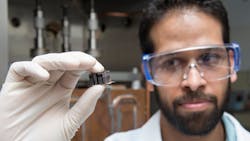Before nuclear war wiped out civilization in the video game series Fallout, American roads purred with cars powered by nuclear generators. Such technology might seem dangerous – or explosive – but the National Aeronautics and Space Administration has equipped satellites and probes with nuclear batteries since 1961.
Now researchers from the Jet Propulsion Laboratory in Pasadena, Calif., are trying to upgrade these power systems to be more efficient, cheaper, and longer-lasting.
With more efficient power systems, the space agency could design cheaper probes using less radioactive material, allowing scientists to send probes deeper into space and to the fringes of the solar system. It could also let rovers explore planets and asteroids longer than they could before without having to rely on solar panels.
“This is particularly important for the outer planets, where the intensity of sunlight is only a few percent as strong as it is in Earth orbit," said Jean-Pierre Fleurial, the laboratory’s supervisor for thermal energy conversion research, in a statement.
But Fluerial and his research team have not been trying to design new power systems from scratch. Instead, they looked at reinventing the radioactive thermoelectric generators that are already used in probes and satellites drifting out to the edges of the solar system.
These generators, which convert heat from decaying plutonium into electricity, are embedded inside the Voyager probes that launched in 1977 and have traveled more than 10 billion miles. The systems were also added to the Mars Curiosity rover and the New Horizons probe, which hurled around Pluto in 2015.
NASA is aiming for the new system, known as the Enhanced Multi-Mission Radioisotope Thermoelectric Generator, or eMMRTG, to complete its final design review before the end of the decade.
The researchers said that the new system will supply 25% more power and twice the lifespan of the generators embedded inside Curiosity. “Having a more efficient thermoelectric system means we'd need to use less plutonium,” said Sabah Bux, a thermoelectric material scientist at NASA, in a statement. “We could go farther, for longer and do more.”
The work could also offer other benefits. A more efficient system could save millions of dollars and years of time that the space agency would spend refining the expensive and deadly form of plutonium required for the batteries. Last year, the stockpile of Plutonium-238 – which was once made as a by-product from manufacturing nuclear weapons – in the United States was only large enough to produce three more batteries. In addition, the material costs about $8 million per kilogram.
The researchers worked on making new types of thermocouples, the devices that actually generate an electric current from the temperature difference in its circuits. While earlier devices were based on alloys of a material called telluride, the new design uses circuitry based on crystalline materials.
They are called skutterudites and have the unique ability to conduct electricity like metal and insulate heat like glass. As a result, the new devices can generate electricity with smaller variations in temperature, making them more efficient.
Like previous thermoelectric generators, the skutterudite components will be placed around a central can-like structure, which contains the plutonium. "Only minimal changes to the existing MMRTG design are needed to get these results," Fleurial said.
But applications for the new design are not limited to spacecraft, said Thierry Caillat, a senior member of the research team. In fact, many engineers use thermocouples to measure temperature in steel-making equipment and gas turbines. And several start-ups are experimenting with them as energy-saving devices.
Last year, NASA licensed its skutterudite patents to Evident Thermoelectrics, an energy harvesting start-up based in Troy, New York. Shortly after, the company released the first products based on the material, saying that the thermocouples could be used to soak up waste heat in industrial processing or to power wireless sensors.
Caillat said that the new thermocouples are even efficient enough to gather waste heat from car exhaust and recycle it into a hybrid vehicle’s battery. Tiny devices could also be embedded in wearable electronics like smart watches to draw power from body heat.
About the Author
James Morra
Senior Editor
James Morra is the senior editor for Electronic Design, covering the semiconductor industry and new technology trends, with a focus on power electronics and power management. He also reports on the business behind electrical engineering, including the electronics supply chain. He joined Electronic Design in 2015 and is based in Chicago, Illinois.


